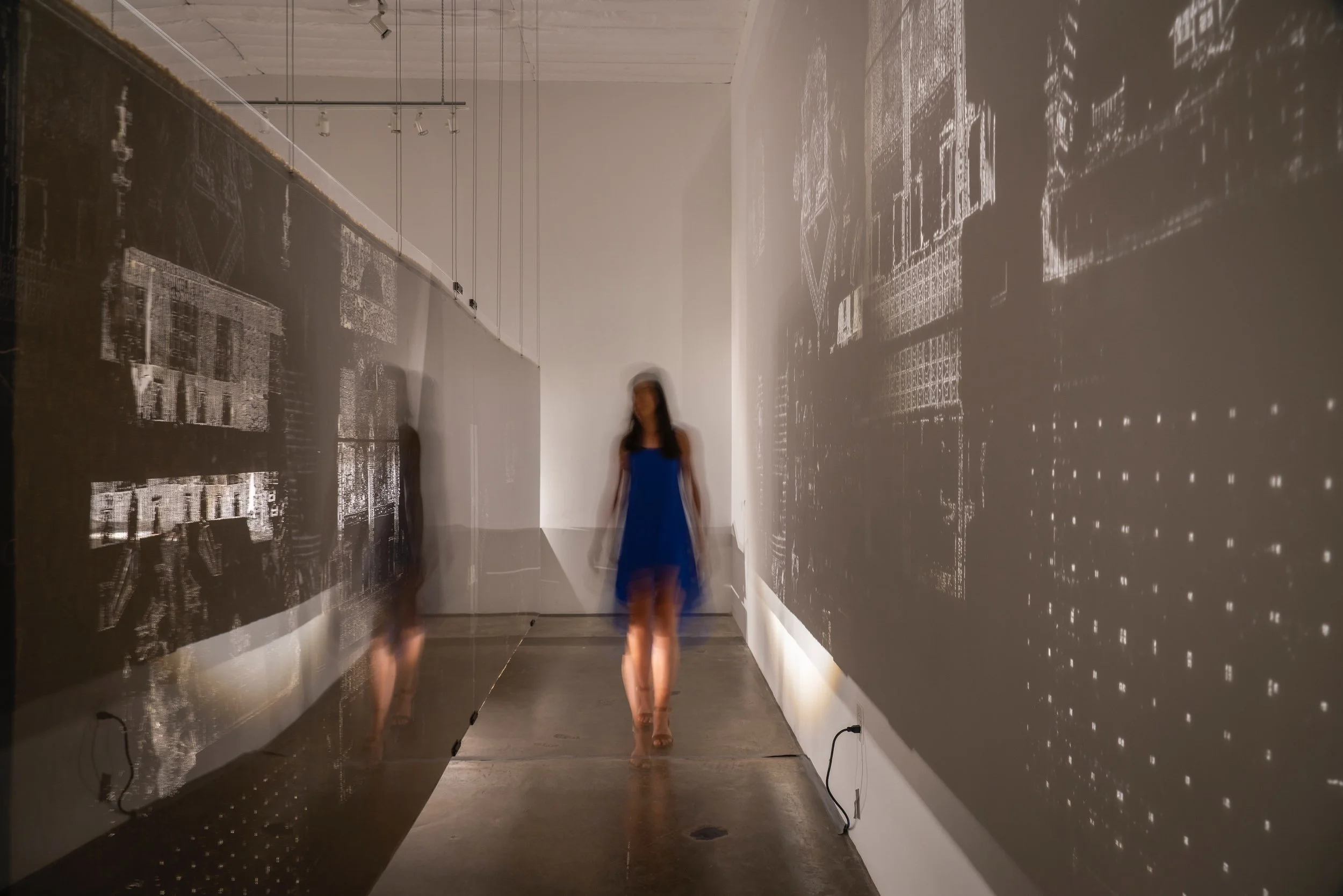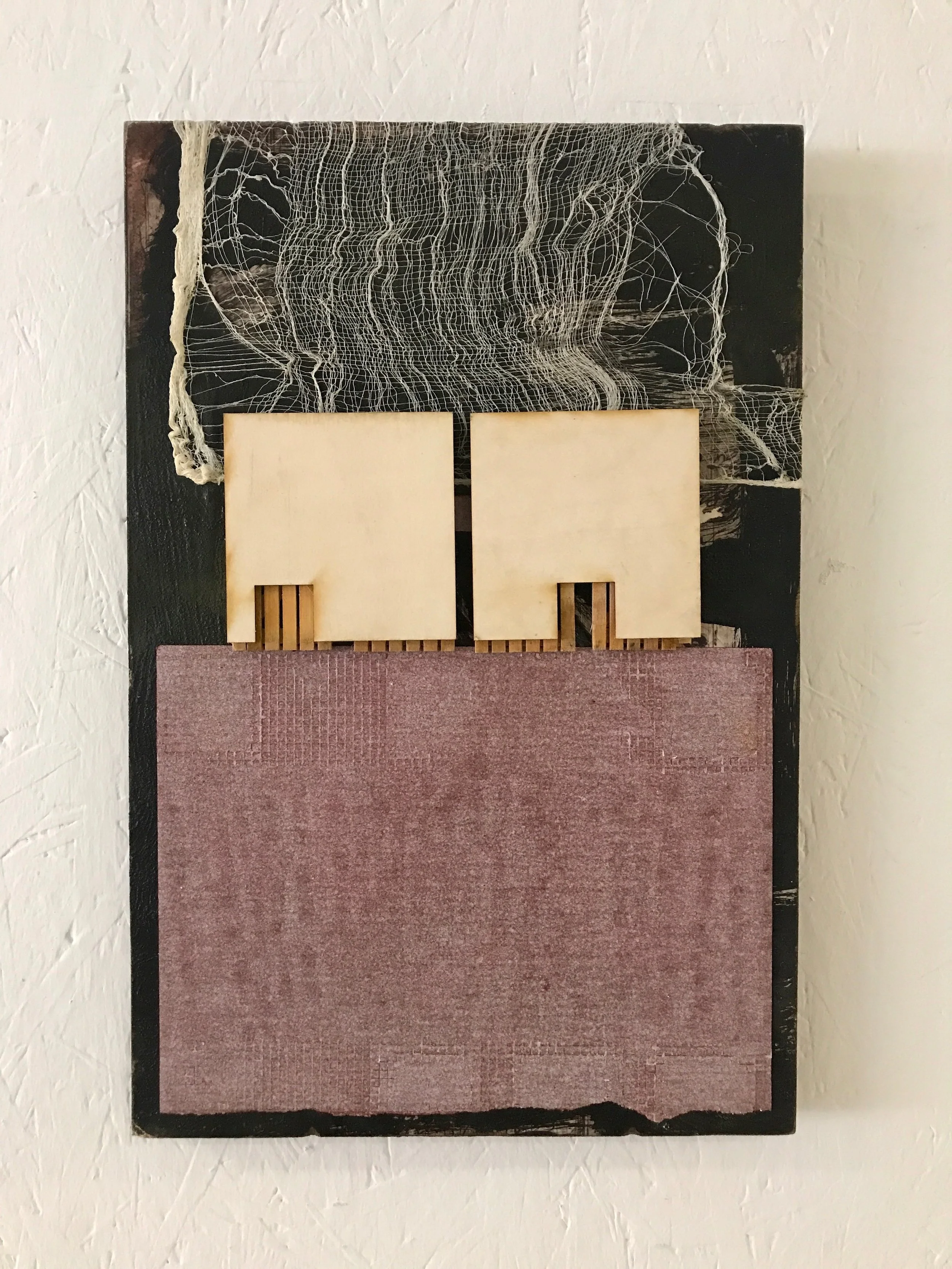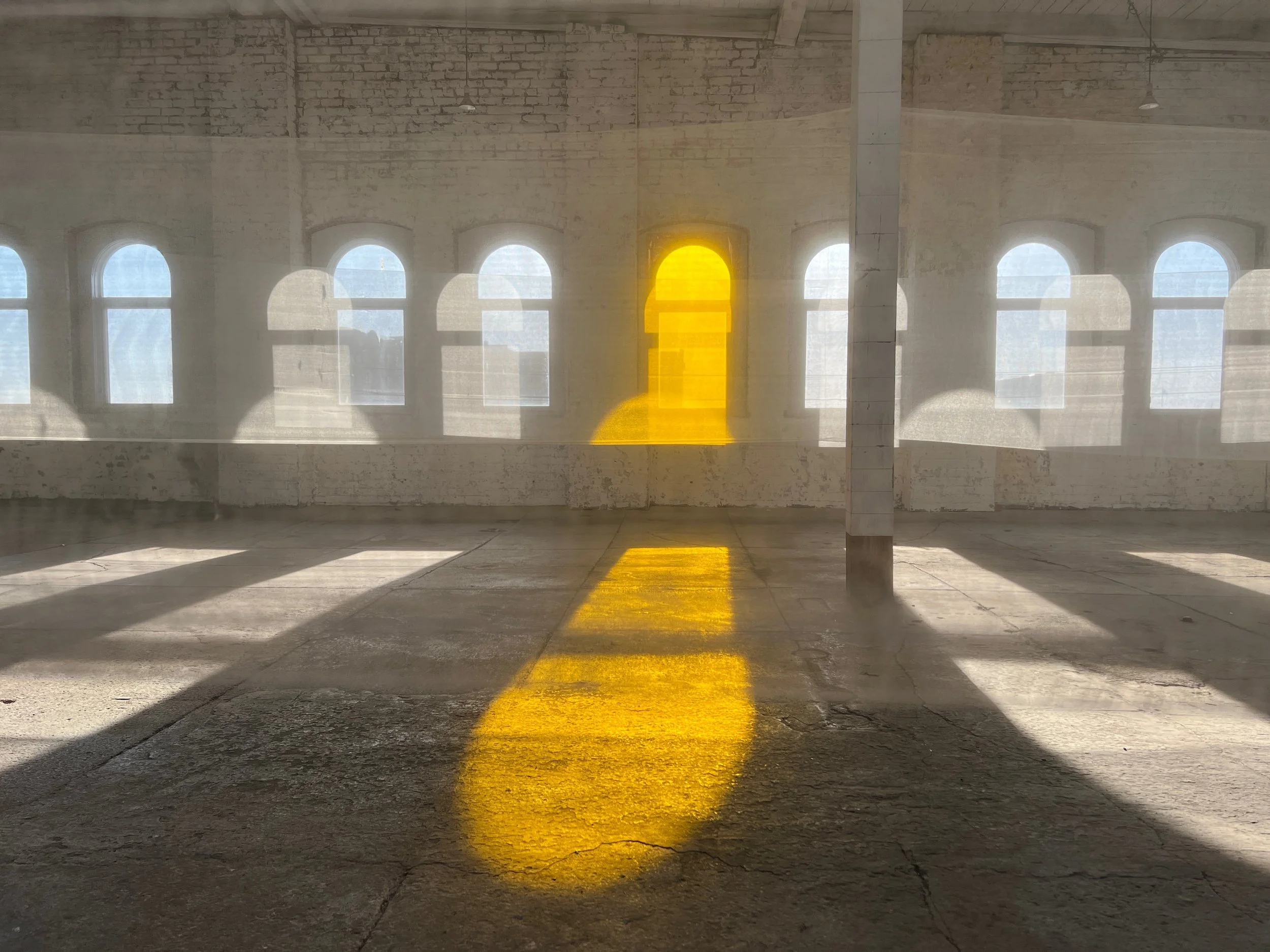Haram Xafra, 2019. Wooden dowels, gauze, pigments, glue, memory, and shadow. 72 x 72 inches (sculpture)’ 120 x 120 inches (shadow). Photo Scott David Gordon.
Rehab El Sadek
BIO
Rehab El Sadek (1972) is a US-based conceptual Egyptian artist whose been exhibiting internationally for thirty years. She utilizes architectural structures, light, shadow, and memory to investigate the layered reality of the immigrant experience. And creates alternative spaces that invite viewers to question existing power dynamics and contemplate the role of individuals-especially the marginalized.
Her work has been exhibited in numerous venues including: The Geffen Contemporary Art at MOCA, Los Angeles, CA; Sharjah Biennial; Rencontres Africaines de la Photographie, Mali; Gasworks Gallery, London; Borusan Sanat Galerisi, Istanbul; Ashkal Alwan, Beirut; Nairobi National Museum, Kenya; Kunsthistorisches Museum, Vienna; Project Row Houses, Houston; The Women's Museum, Dallas; Mexic-Arte Museum; and The Elisabet Ney Museum, Austin. In 2009, EI Sadek was one of 88 female artists included in REBELLE: Art and Feminism 1969-2009-an extensive forty-year survey of feminist artwork organized by the Museum voor Moderne Kunst in Arnhem, Netherlands.
El Sadek has received numerous grants and honors including: The 2023 Pollock-Krasner Grant, Project Row Houses; Southern Survey Biennial Prize, selected by curator Valerie Cassel Oliver, 2022. In 2021: Gottlieb Foundation Individual Grant, NY; Sustainable Arts Foundation Award; Texas Vignette Grant, NPN, 2020 and FCA 2019. Her MacDowell artist residency was supported by the Pollock-Krasner Foundation and the Carnegie Corporation Fellowship. She also held a one-year appointment as the City of Austin's first Artist-in-Residence 2017, investigating social and environmental issues, embedded in the City's Watershed Protection Department.
She has participated in residencies such as: MacDowell; Bemis; Gasworks, London; McColl Center; The Townhouse International, Cairo; Vasl Artists, Karachi; International Artists Residencies, Kenya; Thami Myele for African artists, Amsterdam; Vermont Studio Center; and Art Omi.
El Sadek earned a 5year BFA in painting from the Faculty of Fine Arts, Alexandria, Egypt 1994. She currently lives and works in Austin, Texas.
ARTIST STATEMENT
In my work, I utilize architectural structures, light, shadow, and memory to investigate the layered reality of the immigrant experience. Using repurposed materials, I create alternative spaces that invite viewers to question existing power dynamics and contemplate the role of individuals—especially the marginalized. Placemaking can be a poetic act and a tool to build community.
My practice is also defined by the reuse of common everyday objects and their archeological and conservation journey. Unlike ancient sculptures carved from wood or stone, my works, are constructed from non-durable materials—carved from light-weight foam alludes to the delicate nature of both 21st Century society and modern building techniques: solid on the surface but unable to withstand stress or pressure. The rusticated objects textured with time, protected with gauze. The repeated use of gauze as a material throughout my installations suggests both the ephemerality of life and the persistence of memory. My heritage is also reflected in the material’ ancient use in Egypt for healing, protection and conservation.
Interview with Rehab El Sadek
The Memory Palace, 2019. Mixed media on fabric, projection, and shadow. 60 x 180 x 0.4 inches (fiber art/plexiglass); 120 x 240 inches (shadow). Photo: Scott David Gordon.
Can you tell us a bit about your background and how you became interested in becoming an artist?
I spent the formative years of my childhood in Mersa Matruh, Egypt, a port city on the Mediterranean coast with a rich history, both ancient and modern. It was a strategically important city during the time of Alexander the Great and also World War II. On one side was the sea, on the other a vast desert. Although I didn’t necessarily know who was responsible for them, I grew up fascinated by the mud-brick houses in places like Siwa Oasis and, later, the environmental architecture of Hassan Fathy.
My interests in anthropology and architecture gave way to a passion for studio art and I studied painting, sculpture, and installation art at the University of Alexandria. After college, I aggressively pursued my dreams of being a professional artist. My earliest real exposure to the art world was a residency at Gasworks Studios in London which led to other residencies in Amsterdam, Cairo, and Nairobi.
Can you tell us about some of your most memorable early influences?
My father was a civil servant who worked in cultural affairs so my siblings and I grew up with a great variety of interesting books around the house. One of my earliest creative memories was smashing the keys of my father’s Arabic typewriter and creating repetitive shapes. I’d jam different kinds of paper in there and pound away!
We also had a number of history books with pictures around the house and I’d spend hours looking at them. I would also read Arabic translations of Shakespeare, Alfred Hitchcock mystery digests, and Greek mythology. Being a child of parents in their forties provided a lot of quiet time alone. Lots of time for introspection and escape.
Where are you currently based and what brought you there? Are there any aspects of this specific location or community that have inspired your work?
I’m currently based in Austin, Texas which has been a fantastic and supportive community. In 2017, I was selected as the City of Austin’s first artist-in-residence which was a great honor. Living in Texas, I appreciate the proximity to world-class museums and collections like the Dallas Museum of Art, Fort Worth Modern, Chianati Foundation, and the Menil. All very inspiring!
What is your studio space like? What makes your space unique to you?
For the past decade, I’ve been a bit of a studio nomad. Because I travel back to Egypt for extended periods and attend a high number of artist residencies, it often hasn’t made financial sense for me to maintain a permanent studio space. I’ve done several short-term leases, sublets, etc. This probably has informed my practice. I find myself doing a lot of research and working with light-weight, transportable materials.
Having received a grant from the Pollock-Krasner Foundation to support studio overhead this year, I recently started working in a great, hidden gem of a studio located in a rustic manor inside a wilderness preserve. A handmade mansion built in the seventies by the original owner. Very old Austin. Lizards and scorpions everywhere! My space has high ceilings and enormous windows. Lots of natural light. I appreciate the scenic drive to and from the studio every day; very therapeutic and meditative.
What is a typical day like? If you don't have a typical day, what is an ideal day?
Wake up, eat breakfast and drink a cup of black tea, play fetch with the cat, drive to the studio, start work around 10:00 AM and work for about seven to nine hours each day. In the evening, I listen to records and audiobooks and, if I’m lucky, the aforementioned cat will sit on my lap. She’s very fickle! I also work on applications. On weekends, I like to cook with my teenaged son, work on more applications and do planning.
Superposition, 2021. Wood, industrial foam, wire, wooden dowels, gauze, gypsum, sand, eath pigments, and natural light. Front: Burj Alkanisa: 130 feet x 24 inches x 20 inches. Back: Burj Abyad: 105 x 8 x 8 inches. Photo: Curt Gettman.
What gets you in a creative groove or flow? Is there anything that interrupts your creative energy?
My favorite working conditions are deep silence and having a wide variety of material handy to experiment with. Although much of my work is heavily researched and painstakingly planned, I also try to leave room to improvise with raw materials. I often work on several things at once and cycle between them; I think this helps me maintain a fresh perspective. Also, sometimes I’ll put work aside for months or years but keep developing them in my head. I think some of my most successful works were created this way and initially felt like “interesting failures”.
How do you maintain momentum in your practice?
Hard work and a strict but flexible routine. I also find residencies to be beneficial in that regard. The change of scenery. Creating in a new environment with different resources pushes me to try new things and focus on experimentation. Even during times when I’m not preparing for a show or have a clear goal in mind, I will work every day to keep up momentum. Working everyday makes me feel safe!
What medium/media are you working in right now? What draws you to this particular material or method?
I’m primarily a conceptual artist and an installation artist but also a sculptor. Lately, I’ve been back to a recurring theme in my work which is creating sculptures out of old books. Much of my sculptural work is created using repurposed materials. Originally this was out of necessity, using what was affordable and readily available. A few years back, I also started using light, shadow, and memory as sculptural materials. Extending the volume of installations with long shadows or meditating on specific memories during the fabrication process. The finished works wind up being very autobiographical.
Can you walk us through your overall process in making your current work? Does drawing play a role in your process?
As I’ve been trained as a painter, drawing is in the heart of everything I touch. My works start with written research and drawings for planning. Drawing methodologies then are carried on throughout the process–writing on fabric, glueing gauze to objects, or texturing them. When it comes to the last phase, specifically around nesting objects in space, I translate these physical forms with shadow.
What is exciting about your process currently?
Lately it’s a small thing: incorporating color. Much of my work looks like it could be a few thousand years old. Earth tones and old world textures. It’s the Egyptian in me, I suppose. I haven’t worked with color much since art school which was a long time ago. Figuring out how to incorporate color in a sophisticated way is a fun challenge. It brings something new out in the work.
Homw Plan $7 home with a view by The Dead Sea, 2021. Mixed media on wood. 25 x 14 x 2.5 inches.
Can you talk about some of the ongoing interests, imagery, and concepts that have informed your process and body of work over time? How do you anticipate your work progressing in the future?
I have a recurring memory of a room filled with ancient Egyptian mummies and, with it, intense thoughts about the afterlife. This is the original Cairo Museum located in Tahrir Square, Cairo, 1997. I can still picture the interior spaces in great detail. A memory palace. I spent a lot of time here after my father’s death. He passed unexpectedly during my first year of art school. As an artist, I think my shift from painting to installation and conceptual art can be traced back to this time. And, specifically, being inspired by this room. The design details of the coffins, ancient writings in fading inks, bodies wrapped in gauze. These people were all once alive with hopes and dreams. Loved and were loved. I felt a connection to my ancestry going back thousands of years.
Following this experience, I began wrapping sculptural objects in gauze mummification-style. This has since become a recurring part of my practice. For me, the material suggests both the ephemerality of life and persistence of memory. Continuing this practice honors my heritage. As for the future, I see my work becoming more abstract–valuing singularity and repetiveness.
Do you pursue any collaborations, projects, or careers in addition to your studio practice? If so, can you tell us more about those projects, and are there connections between your studio practice and these endeavors?
I’ve become more focused on the social practice part of my art in recent years. I enjoy collaborating with “non-artists” and am looking to work more with immigrants and refugees in the near future. Conversations with them are inspiring and deeply meaningful.
Gauzing, 2022. Gauze, architecture, plexiglass, wood, and natural light.
Have you had any epiphanies recently that have changed the course of your work or caused you to shift directions?
Sometimes after works are shaped, I experience the feeling that I might have made them before. I love lingering a while between sleep and wakefulness. In this in-between state of mind is usually when I get the clearest vision of the work. It seems silly but it really happens!
Can you share some of your recent influences? Are there specific works—from visual art, literature, film, or music—that are important to you?
I’ve been strongly influenced by the innovative methodologies of pioneering 20th-century artists (Joseph Beuys, Louise Bourgeois, Gonzalo Fonseca), conceptual writers (Italo Calvino, Jorge Luis Borges), and architects such as Aldo Rossi. Architecture in general is a huge influence. Both ancient and modern. A recent influence has been the “Pattern Language” method described in the written works of architect and design theorist Christopher Alexander. As part of my creative process, I’ve been using Alexander’s toolkit to design how viewers experience my work.
Who are some contemporary artists you’re excited about? What are the best exhibitions you’ve seen in recent memory and why do they stand out?
This might sound funny but, as an Egyptian, contemporary art for me means anything from the last 100 years! That said, some standout shows from the recent past were the Beatriz Gonzalez and Alberto Giacometti retrospectives at the Houston Museum of Fine Art. I appreciated seeing the arc of their artistic practice and lives. I was also deeply moved by Julian Charrière's Vision of Fire and Ice at the Dallas Museum of Art, especially his night time film of the melting glacier. Beautifully photographed but ultimately terrifying. Sadly, I haven’t been to many shows outside Texas since the pandemic. I should probably fix that soon.
Penumbra (detail) spinning, 2022. Mixed media, movement, and shadow in a Row House.
Do you have any tips or advice that someone has shared with you that you have found particularly helpful?
Apply for opportunities even the ones that seems out of reach! Make it part of your weekly routine. It for no other reason than it forces you to reflect on your practice and teaches you how to talk about your work. Filling out applications makes you a better, more self-aware artist.
What are you working on in the studio right now? What’s coming up next for you?
Surprisingly, to myself anyway, I’ve recently gotten back into painting! I’ve spent years denying my formal training (my degree is in painting).
Thank you so much for sharing your work with us!
Thank you for asking me! I truly appreciate the opportunity.
To find out more about Rehab El Sadek check out her Instagram and website.






